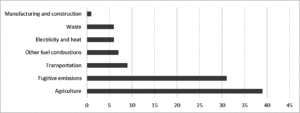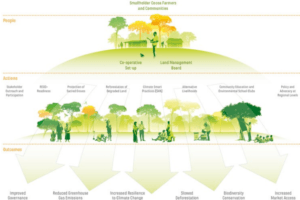What can Nigeria learn from Olam’s climate change program?

Olam, founded in Nigeria in 1989, is a leading agri-business that supplies food to 16,000 customers around the world. Today, Olam is working with its suppliers, four million farmers, to mitigate and adapt to climate change.
Climate change in Nigeria
Nigeria is one of the most vulnerable countries to climate change in the world [1]. The stability of its food systems is under serious threat from climate change [2]. The extreme conditions caused by climate change (such as floods, drought, reduced soil fertility, pests and diseases) have led to reduced crop yields [3]. Climate change is matter of life and death as majority of Nigerians depend on rain-fed agriculture for their income [4].
How is Olam addressing climate change?
Olam has a few climate change initiatives. First of all, Olam is working to reduce the greenhouse gas emissions from its farming and processing operations. It understands that agriculture is the biggest producer of greenhouse gas emissions in Nigeria. With its leverage as a major buyer of agricultural produce, Olam is motivating its suppliers (farmers) to reduce their greenhouse gas emissions [5].
Greenhouse gas emissions in Nigeria by sector [6]
Climate Change is a threat to Olam’s business. For its agricultural operations, it is working on climate resilience and adaptation techniques to mitigate against the negative effects of extreme weather conditions. Examples of adaptation techniques include planting of shade trees and using various landscape methods to increase water retention in soil.
Agricultural produce, Olam’s raw material, may see significant changes in quantity, quality and price due to the impacts of climate change. For example, the crop yields of farmers who supply Olam may be reduced due to water scarcity. Olam is collaborating with over four million farmers to modify their farming techniques to mitigate the risks of climate change or adapt to the effects of climate change.
Cocoa landscape in West Africa (Click on image for better quality) [7]
What else should Olam consider?
Olam stands to benefit from its climate change program. There is an obvious benefit of mitigating its supply chain risks. This may be a source of significant competitive advantage. The use of more sustainable agricultural practices and food production systems should also boost Olam’s reputation in markets where it operates.
In December 2015, Nigeria, with over 190 other countries, submitted a pledge to the Paris Climate Summit to reduce its contribution to emissions by 45 percent by 2030 [8]. To encourage sustainability initiatives, Nigeria may in the future reward firms that develop sustainable value chains in Nigeria and reduce greenhouse gas emissions with tax breaks, for example.
Olam should emphasize its support for tackling climate change in Nigeria by channeling sum of its corporate social responsibility funds to support Nigeria’s climate change research to, for example, develop seeds that thrive in certain extreme conditions common in Nigeria.
What can Nigeria learn?
While agriculture in Nigeria suffers from climate change, it is also a leading producer of greenhouse gas emissions. Agricultural practices such as fertilizer use and deforestation contribute to emissions [9]. Nigeria should use policy to discourage farmers from employing practices that have significant negative impact on the environment.
Nigeria should also establish a unit in its Department of Climate Change (Ministry of Environment) to coordinate the activities of non-profits and companies (such as Olam) working on climate change to maximize efficiency. This unit should also propose and advertise turnkey climate change projects for nonprofits and companies to lead or sponsor.
Olam has shown that companies are willing to invest in tackling climate change. Nigeria may exploit the corporate social responsibility (CSR) allocations of companies to fund climate change programs. Some countries, such as India, take advantage of CSR funds to run social programs. India, in fact, mandates CSR by imposing a two percent tax on profits [10].
Through its climate change program, Olam has shown that there is a business case for companies to employ sustainable practices and fight climate change. Nigeria needs to encourage more companies to develop such programs so that it may reduce the impact of climate change on its citizens and meet its emission targets for 2030.
Word count: 688 words
Endnotes:
[1] IPCC, 2007. Climate Change 2007: Impacts, Adaptation and Vulnerability, New York: Cambridge University Press
[2] Edame, G. E., Anam, B. E. & Fonta, W. M., 2011. Climate Change, Food Security and Agricultural Productivity in Africa: Issues and Policy Directions. International Journal of Humanities and Social Science, 1(21)
[3] EPA, 2016. Climate Impacts on Agriculture and Food Supply, Washington, DC: US
[4] IFPRI, 2010. Enhancing agricultural productivity and profitability in Nigeria, Abuja: International Food Policy Research Institute.
[5] Olam, 2016. How is Olam contributing to the international two degrees Celsius target goal? [Online] Available at: http://olamgroup.com/sustainability/sustainability-reports/crs-report-2015/material-areas/climate-change/olam-contributing-international-2oc-target-goal/ [Accessed 1 November 2016].
[6] WRI, 2005. Climate Analysis Indicators Tool, Washington, DC: World Resources Institute.
[7] Noponen, M., 2016. Supporting Cocoa smallholders to transcend the boundaries of climate change. [Online] Available at: http://olamgroup.com/blog/supporting-cocoa-smallholders-transcend-boundaries-climate-change-2/ [Accessed 1 November 2016].
[8] UNFCC, 2015. INDC. [Online] Available at: http://www4.unfccc.int/submissions/indc/Submission%20Pages/submissions.aspx [Accessed 1 December 2016]
[9] FAO, 2014. Agriculture, Forestry and Other Land Use Emissions by Sources and Removals by Sinks, Rome: United Nations.
[10] Banerjee, J., 2013. India Mandates Corporate Social Responsibility: The 2 Percent Bill, New York: GBCHealth.
Cover image and description:
Olam, 2016. Olam Sustainability: Climate Change. [Online] Available at: http://olamgroup.com/sustainability/sustainability-reports/crs-report-2015/material-areas/climate-change/ [Accessed 1 November 2016].





This article highlights the key issues regarding Olam’s climate change program, in that agriculture must reduce its impact on greenhouse gas emissions. While it is questionable as to whether Nigeria and others who submitted a pledge to the Paris Climate Summit will reduce emissions by 45 percent in 2030, it does bring up the issue of who will enforce such a change and how it will actually be implemented. Ultimately, a market mechanism must be used to incentivize firms to reduce. Instead of taking a “social responsibility tax” from corporations to aid in reducing the amount of greenhouse gas emissions from agriculture, issuing tax credits may provide enough incentive for firms and countries to come up with innovation solutions, since the credit can be applied across organizations and has an immediate impact on the bottom line.
Another interesting point here is who will provide the capital to drive the reductions in emissions. With the CSR funds of companies as mentioned in the above article be sufficient to drive such a dramatic reduction in emissions? Additionally, provided the capital does exist, do farmers have the capability to implement changes required?
The post above mentions that Olam may hold a competitive advantage by mitigating risk in the supply chain and developing more efficient food production systems. While this is likely true over the long term, does this put Olam at a competitive disadvantage for the short term? With increased costs in these initiatives, will Olam’s ability to serve its customers suffer? How can the government of Nigeria step in to ensure that increased costs in order to decrease emissions does not put companies at risk?
Finally, has Olam explored working with farmers to import genetically modified seeds? While likely more expensive initially, there may be an opportunity to deliver a more consistent yield through genetically modified crops that are more resilient. Olam could share the cost with farmers to ensure a more stable yield and lower supply chain risk. This is also quite controversial.
Great read. Reading this article made me think of countries such as Israel who have managed to wrestle growth out of some of the most inhospitable agricultural conditions in the world by being creative. In the Israeli’s case, it was the result of unique irrigation practices, technology that has been successfully exported to other countries. Similar thinking could help not only Olam, but Nigeria as well. But, much of this innovation has to be driven by the government since it frequently requires significant upfront capital investment. I would suggest that the Nigerian government promote this growth through policies that provide subsidies or tax credits to companies like Olam who are trying to uniquely think through problems. Being a technology leader should reap the Nigerian government out-sized rewards as other countries come to them as they too struggle with similar problems.